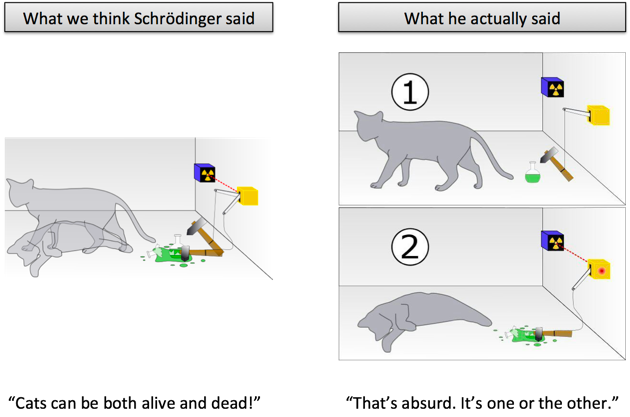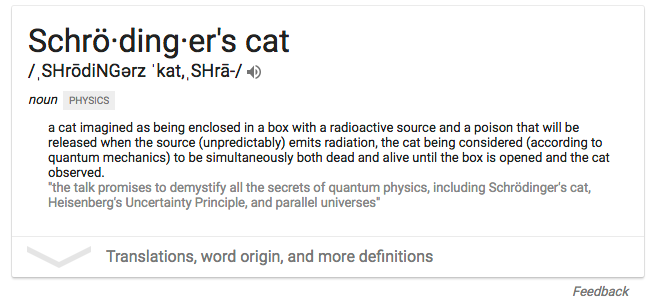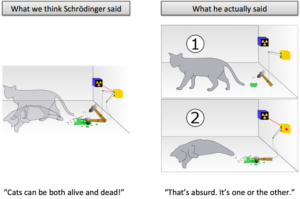What do you know about Schrödinger Cat? Probably something like this:
A cat is in a box with a radioactive source and a poison that will be released when the source (unpredictably) emits radiation. According to quantum mechanics, the cat is simultaneously both dead and alive until the box is opened and the cat observed.
The story seems to be that Quantum Mechanics is so weird, a cat can be both alive and dead until we look!
Except this misses the point. Here's what Schrödinger wrote:
One can even set up quite ridiculous cases. A cat is penned up in a steel chamber, along with the following device (which must be secured against direct interference by the cat)...
It is typical of these cases that an indeterminacy originally restricted to the atomic domain becomes transformed into macroscopic indeterminacy, which can then be resolved by direct observation. That prevents us from so naively accepting as valid a "blurred model" for representing reality. In itself, it would not embody anything unclear or contradictory. There is a difference between a shaky or out-of-focus photograph and a snapshot of clouds and fog banks.
Here's his argument:
- Quantum mechanics claims subatomic particles can be in a "blurred" indeterminate state
- If that's the case, create a scenario where subatomic bluriness determines the fate of a macroscopic object
- Because it's absurd for a macroscopic object to be "blurred" (right?), the subatomic particle can't truly be blurred
- Analogy: Just because a camera is out of focus doesn't mean things in the world are actually blurry

See, I don't know anything about QM. But I've read enough (2 paragraphs of his paper) to realize the majority of QM explanations miss Schrödinger's point.
Schrödinger's story is a critique of the idea of quantum blurriness. But, some pop sci author read the story, thought it was meant to be interpreted literally ("Large felines can exhibit quantum blurriness") and countless others retell the explanation, not the story. It's like hearing that the Emperor's New Clothes is about the eye-opening power of fashion without reading the tale yourself.
Now, we all misunderstand things. But, let's try to misunderstand the source material and not a retelling. Would you trust a book review from someone who only read other reviews?
After we understand the original argument, we can debate whether the criticism makes sense. If particles appear to be blurry at a quantum level, then perhaps:
- We just lack information. Maybe there's some hidden variable that clarifies what state we're in. (But Bell's theorem seems to rule that out.)
- Both events happened, but we don't know which alternate universe we're in. Maybe every possible outcome creates a new timeline. (I flip a coin and put it under my hand. Are we in a spooky quantum state?)
- Maybe the surrounding environment itself "observes" the cat and puts it into a settled state long before we check.
- Or maybe the world is truly blurry until observers come along ("Copenhagen interpretation")
The story continues, as Einstein later wrote to Schrödinger:
You are the only contemporary physicist, besides Laue, who sees that one cannot get around the assumption of reality, if only one is honest. Most of them simply do not see what sort of risky game they are playing with reality—reality as something independent of what is experimentally established. Their interpretation is, however, refuted most elegantly by your system of radioactive atom + amplifier + charge of gunpowder + cat in a box, in which the psi-function of the system contains both the cat alive and blown to bits. Nobody really doubts that the presence or absence of the cat is something independent of the act of observation.
Einstein thought Schrödinger refuted the notion that reality was "blurry" and depended on the observer. The universe has already worked out what happened before you looked (hence his famous quote, "God does not play dice.").
Again, I don't claim to know anything about quantum mechanics. This about reading the source text and recognizing that the Schrödinger's Cat was used as a reductio ad absurdum, and is not what Schrödinger believed.
Philosophically, the issue reminds me of how we think about infinitely small quantities. Do infinitesimals exist?
- No: There's no such things as "infinitely small" things -- things are there, or not there. But they may be too small for you to detect.
- Yes: There are fuzzy "infinitely small" quantities that blip away to 0 when we measure them, but are non-zero in their own world. These tiny quantities can interact with each other and can predict how our "macroscopic" numbers behave.
What is the crossover point between undetectable and detectable, blurry and certain? When does quantum behavior disappear in favor of the everyday, macroscopic reality we're used to? Can we "chain together" reality so tiny behaviors determine larger ones? That's the direct question Schrödinger's Cat raises.
The meta-lesson is that while analogies are memorable, we need to sanity check them with the source material every now and again. After layers of retellings we can miss the original meaning, so let's stay open to correcting our understanding.
Happy math.
References
Wikipedia Article on Schrödinger's Cat - Wikipedia is difficult to learn things from, but has great lists of references
Current Google Definition - Note it doesn't say the argument was meant as a criticism against quantum mechanics

Elon Musk: "Reading the source material is better than reading other people's opinions about the source material."
